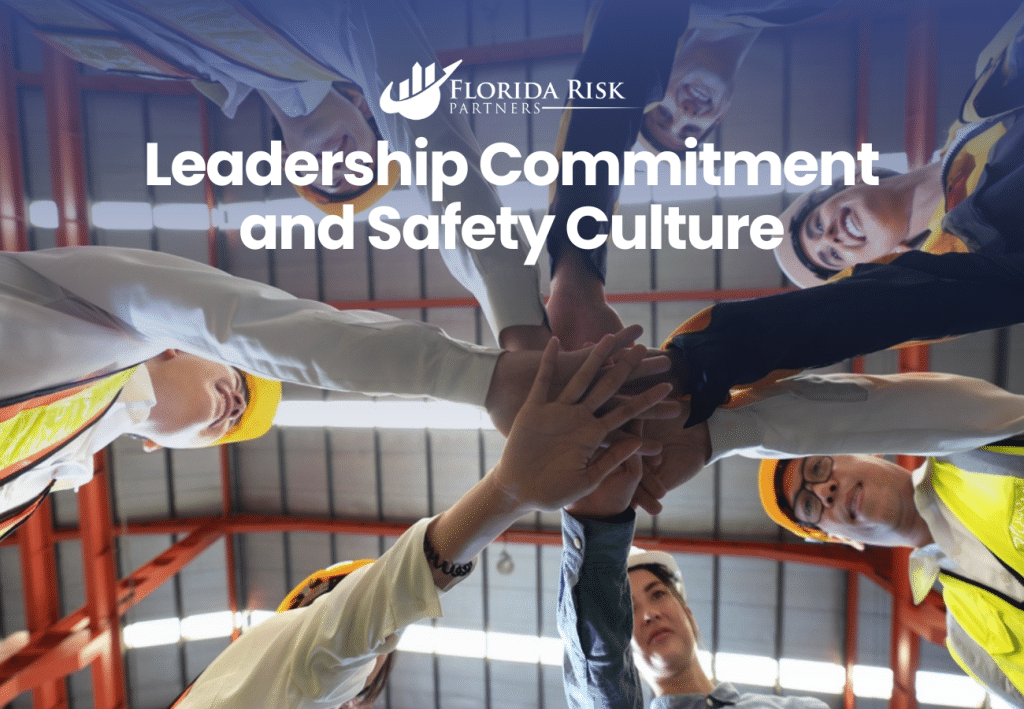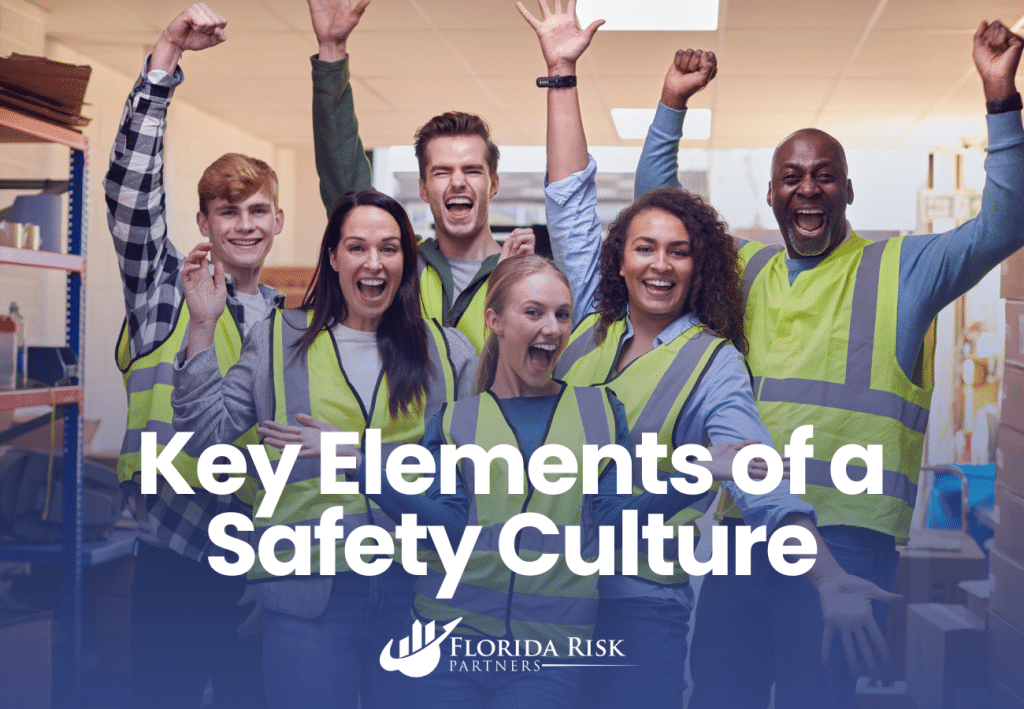-
Main Office: 1434 E. Bloomingdale Ave Valrico, FL 33596-6110
-
Phone: (888) 601-6660
-
Email: info@floridariskpartners.com

In the realm of workplace safety, leadership commitment is not just a component of success—it’s the cornerstone. A strong, visible commitment from leadership is essential for fostering a safety culture that permeates every level of an organization. When leaders prioritize safety, it sends a clear message to employees that their well-being is of utmost importance. This commitment is crucial for developing and maintaining a safety culture where everyone, from top management to frontline workers, actively participates in ensuring a safe work environment.
This blog post will explore the critical role of leadership in building and sustaining a safety culture, the benefits of such a culture, and practical steps leaders can take to demonstrate their commitment to safety.
The Importance of Leadership Commitment in Workplace Safety
Leadership commitment to safety is about more than just words—it’s about action. When leaders genuinely prioritize safety, it influences the entire organization. Here’s why leadership commitment is vital:
- Setting the Tone for Safety Culture: Leaders set the tone for the entire organization. When they prioritize safety, it becomes a core value that is embraced at every level. Employees are more likely to follow suit when they see that safety is a top priority for their leaders.
- Building Trust and Confidence: A visible commitment to safety builds trust between leadership and employees. When employees know that their well-being is genuinely valued, they are more likely to feel confident in their work environment and more engaged in their roles.
- Enhancing Compliance and Accountability: Leadership commitment ensures that safety protocols are followed and that there is accountability at all levels. When leaders enforce safety standards, it creates a culture where compliance is the norm and deviations are swiftly addressed.
- Driving Continuous Improvement: Leaders who are committed to safety are always looking for ways to improve. They encourage feedback, invest in new safety technologies, and support ongoing training programs to ensure that safety practices evolve with the organization’s needs.
- Reducing Accidents and Injuries: Ultimately, leadership commitment to safety leads to fewer workplace accidents and injuries. By prioritizing safety, leaders help to create a work environment where risks are minimized, and employees can perform their duties without fear of harm.
Key Elements of a Safety Culture
A safety culture is defined by the collective attitudes, beliefs, and practices that prioritize safety in the workplace. Building such a culture requires intentional effort from leadership. Here are the key elements of an effective safety culture:
1. Shared Safety Values
At the heart of a safety culture are shared values that emphasize the importance of safety. These values are communicated and reinforced by leadership at every opportunity.
- Safety as a Core Value: Safety should be seen as a core value, not just a priority that can shift over time. It should be integral to the organization’s mission and vision.
- Consistency in Messaging: Leaders should consistently communicate the importance of safety in all aspects of the organization, from meetings and trainings to daily interactions with employees.

2. Employee Involvement and Empowerment
A safety culture thrives when employees are actively involved in safety initiatives and feel empowered to contribute to a safer work environment.
- Encouraging Participation: Leaders should encourage employees to participate in safety committees, report hazards, and suggest improvements. This involvement fosters a sense of ownership and responsibility for workplace safety.
- Empowerment to Act: Employees should feel empowered to act when they identify safety concerns. This means having the authority and support to address issues immediately, without waiting for approval from higher-ups.
3. Open Communication and Transparency
Effective communication is essential for a safety culture. Leaders must create an environment where open, honest communication about safety is encouraged and valued.
- Open-Door Policy: Leaders should maintain an open-door policy where employees can freely discuss safety concerns without fear of reprisal.
- Transparent Reporting Systems: Implementing transparent reporting systems for safety incidents, near misses, and hazards ensures that issues are addressed promptly and that lessons are learned from every incident.
4. Continuous Learning and Improvement
A safety culture is dynamic, not static. It requires continuous learning and a commitment to improvement from everyone in the organization.
- Regular Training Programs: Ongoing training and refresher courses help keep safety knowledge up-to-date and reinforce the importance of safe work practices.
- Safety Audits and Reviews: Regular safety audits and reviews allow the organization to assess the effectiveness of safety measures and make necessary adjustments.
5. Visible Leadership Engagement
Leaders must be visibly engaged in safety initiatives. This involvement demonstrates their commitment and sets an example for others to follow.
- Active Participation in Safety Programs: Leaders should actively participate in safety meetings, audits, and training sessions. Their involvement signals that safety is a priority for the entire organization.
- Recognition and Rewards for Safety: Recognizing and rewarding safe behavior and successful safety initiatives reinforces the importance of safety and motivates employees to maintain high safety standards.
Steps for Leaders to Demonstrate Commitment to Safety
Leadership commitment to safety is not just about endorsing safety policies—it’s about being actively involved in promoting and sustaining a safety culture. Here are practical steps leaders can take to demonstrate their commitment:
1. Lead by Example
Leaders must model the behavior they expect from their employees. This means following all safety protocols, wearing required PPE, and adhering to safety procedures at all times.
- Demonstrating Safe Behavior: When leaders consistently demonstrate safe behavior, it sets a standard for the rest of the organization.
- Participating in Safety Initiatives: Leaders should participate in safety initiatives, such as safety audits, training sessions, and emergency drills, alongside their employees.

2. Allocate Resources for Safety
Commitment to safety requires more than just verbal support—it requires investment. Leaders should allocate the necessary resources to ensure that safety measures are implemented and maintained.
- Investing in Safety Equipment: Providing employees with the best safety equipment and technology shows a commitment to their well-being.
- Budgeting for Training Programs: Regular training is essential for maintaining a safe work environment. Leaders should ensure that there is adequate budget for ongoing safety training and education.
3. Engage with Employees on Safety Issues
Leaders should regularly engage with employees on safety issues. This can be done through safety meetings, one-on-one discussions, and informal conversations.
- Seeking Employee Feedback: Leaders should actively seek feedback from employees on safety practices and use this feedback to make improvements.
- Recognizing Safety Contributions: Acknowledging employees who contribute to safety initiatives helps reinforce the importance of safety and encourages others to get involved.
4. Communicate the Importance of Safety
Clear and consistent communication about the importance of safety is key to building a safety culture. Leaders should take every opportunity to emphasize that safety is a core value.
- Safety in All Communications: Safety should be a recurring theme in all communications, from company newsletters to team meetings.
- Celebrating Safety Successes: Publicly celebrating safety milestones, such as accident-free days, helps keep safety at the forefront of everyone’s mind.
5. Hold Everyone Accountable
Accountability is critical in maintaining a safety culture. Leaders must hold themselves and others accountable for following safety protocols and addressing safety concerns.
- Enforcing Safety Standards: Leaders should enforce safety standards consistently and fairly, ensuring that everyone is held to the same high standards.
- Addressing Non-Compliance: Addressing non-compliance with safety protocols promptly and effectively shows that safety is non-negotiable.
Conclusion: The Impact of Leadership on Safety Culture
Leadership commitment is the driving force behind a strong safety culture. When leaders prioritize safety and take active steps to promote it, they create an environment where safety is valued, risks are minimized, and employees feel secure. A robust safety culture not only protects employees but also enhances productivity, reduces costs associated with accidents, and improves overall organizational performance.
For organizations looking to strengthen their safety culture, it starts with leadership. By demonstrating a genuine commitment to safety, investing in necessary resources, and engaging with employees, leaders can build a culture where safety is not just a priority but a fundamental value that everyone shares.
By fostering a safety culture through leadership commitment, organizations can achieve excellence in both safety and performance, creating a work environment where everyone thrives.
Call Us Or
Schedule an Appointment
Select an agent below to view our online calendars and select a day and time that works best for you or call us directly at 888-601-6660. When you use our online calendars, you will receive an email with more information.



